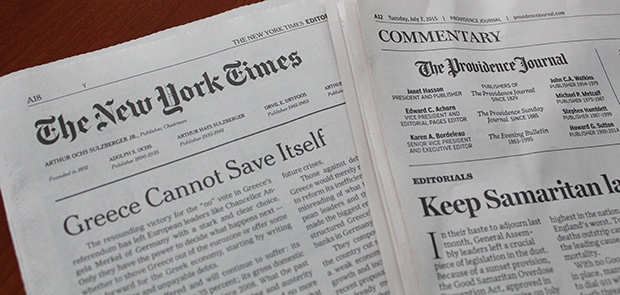Steve Cohen ’75 on How to Get Op-Eds Published
July 27, 2015

One of the most effective tools to influence public opinion and ultimately, public policy, is the opinion page of major newspapers. Steve Cohen ’75 — a lawyer with a background in publishing and teaching — has had remarkable success in writing opinion pieces for the New York Times and the Wall Street Journal. Over the past two years, Cohen has placed ten opinion pieces on education, national defense, and law in those two publications. Last semester, he shared insider tips for translating policy ideas to publication-worthy opinion pieces. Before sharing the lessons he has learned — through failure and success — he had a question for the audience.
“How many people in the room are interested in selling?” (No hands raised.)
“You are all going to be selling. Selling to your boss, selling to your colleagues, and selling to a larger audience of influencers and policy makers. It’s important to learn how to sell, ” Cohen said. Here are Steve Cohen’s tips to help you sell your policy ideas to the press, and ultimately, the public.
1) You will get rejected. Steve Cohen gets rejected, too. Get used to it. Do not take it personally. For the top publications the odds are slim. The New York Times gets 500 submissions daily for two slots from outside commentators. Chances are slightly better at the WSJ, which has the same number of submissions for four slots.
2) Become familiar with the publication in which you want to be published. What sort of pieces do they publish? Understand their particular rules of submission.
3) Think small. Cohen wanted to write about the relationship between reform limiting damages in malpractice lawsuits and patient safety. His piece had been rejected by large publications. A colleague suggested he try to get an opinion piece in KevinMD. He had never heard of it, but it is the most widely read health blog, mostly read by doctors and policy makers. The piece was published, and in Cohen’s telling, generated a lot of comment.
4) Use accessible language. Don’t write in academic style, using buzzwords or technical terms that a lay reader won’t understand. If a sentence has more than two commas, it’s probably too long. Follow Henry Luce's (founder of Time) rule: “it’s not what you put on the paper that matters. It’s what comes off the paper into the reader’s mind, that really counts.”
5) Find an honest critic. “This is the most important piece of advice I can give you,” said Cohen. Find someone who will read your work and let you know if your argument is not working.
6) Say something newsworthy. What is the rationale for publishing the piece now? “Be tough on yourself when answering this question,” said Cohen.
7) Follow the two-thirds formula. Your writing should be one-third prescriptive and two-thirds descriptive. Lay out what the solution is, then describe the problem.
8) Demonstrate that you can promote your work. Use a Twitter account. Build a following. You are more likely to be published if you have standing in your field.
9) Build a hook. This relates tip #6. Is there a new study out in an academic journal that has impact on the public at large? Cohen recounted his own experience with jumping from thinking small (#3) to building a hook for a larger audience. New England Journal of Medicine published an article by five doctors who looked at the effects of medical malpractice tort reform on emergency medicine, the topic Cohen had taken on in KevinMD. This new article gave Cohen and the newsworthy hook to “rehash” some of the arguments he had made in his KevinMD piece, this time in the New York Observer.
10) Have a point of view. Take a position. Opinion writing is not journalism. You don’t have to represent both side.
11) Be provocative. Contrarian arguments, given the right audience, can be embraced.
12) Explain why you’re an expert. Make the case in your query letter. Why are you the right person to comment on this issue?
13) Write no more than 850 words. If they want more or less, they will ask for more or less.
14) Do not submit the same article to more than one publication. Wait until you get a rejection to move on to the next publication. The timing on when you'll receive an answer is different for every publication. Follow up after a week after submission if you don’t receive a response.
15) Make your first contact a query. Do not send unsolicited attachments, even if you have a connection to the recipient. Use the subject line of your email to say “query” and keep it to three lines: 1) the subject you’re interested in writing about; 2) why it’s newsworthy now; 3) why you should be the one to write about it. Always wait for permission to send the attachment.
16) Work your network. If you see a colleague has been published somewhere, ask who their editor is and whether they’d be willing to share that contact. Note: follow all of the other rules even if you have an in.
17) Know a publication’s rules (and biases). For example, the Wall Street Journal doesn’t publish commentary on its own articles. The New York Times, which doesn’t publish right-wing opinion, does extensive fact-checking, unlike many other publications. Provide thorough background for every factual statement you make.
18) Persevere. As they say, if it at first you don’t succeed, try again.

